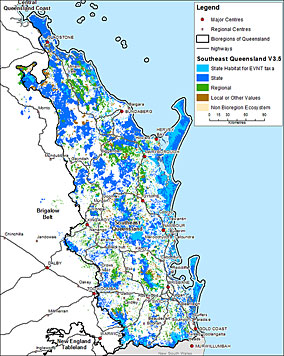Southeast Queensland Bioregion BPA

A Biodiversity Planning Assessment (BPA) is available for the Southeast Queensland Bioregion (Figure 1).
Bioregion
Southeast Queensland
- View the Fauna expert panel report (PDF, 1.57MB), Flora expert panel report (PDF, 2.63MB), Landscape expert panel report (PDF, 3.71MB) or the Summary report (PDF, 2.61MB).
- The BPA results in GIS format as well as the methodology and expert panel reports are available via the Queensland Spatial Catalogue.
Summary
Results from the updated South East Queensland Biodiversity Planning Assessment (BPA) suggest that approximately 97% of the remnant vegetation of the SEQ bioregion is considered of either State or Regional significance. This high proportion is not unexpected, as the region is highly fragmented, with greater value being placed on remaining vegetation.
Diagnostic criteria (including habitat for threatened taxa, vegetated tract size and ecosystem diversity, connectivity) accounted for half of the study area being assigned as being of State biodiversity significance.
In addition, fauna, flora and landscape ecologists identified 92% of the SEQ bioregion as having State or Regionally significant biodiversity values. Values attributed by experts included the identification of wildlife refugia, areas containing high species richness, concentrations of endemic species, or which contain important habitat for priority taxa, as well as the delineation of landscape scale ecological corridors for example. The SEQ BPA also included a new sub-criteria which provided for the nomination of areas likely to act as climate refugia.
Biodiversity within Southeast Queensland is facing several threats as a result of rapid population growth, unsustainable land management practices and native vegetation clearing. BPAs, such as the current SEQ BPA can be used as a decision support tool to aid in land planning and conservation prioritisation to manage and protect biodiversity values.
Release version
4.1
Release date
30 September 2016
For further information on Biodiversity Assessment and Mapping Methodology (BAMM) and the BPA results, email biodiversity.planning@des.qld.gov.au.
